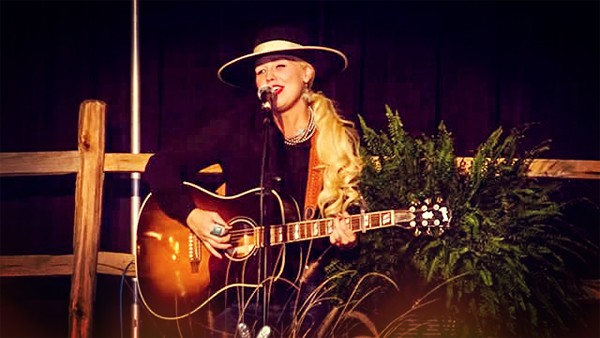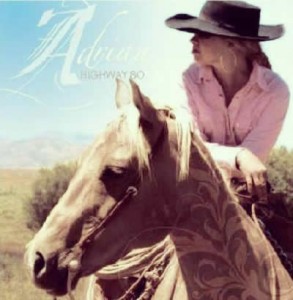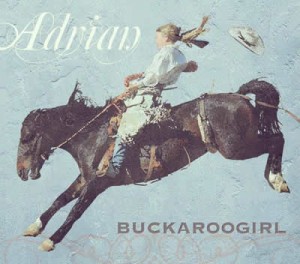“We’re a small genre, out there in the cowboy genre right now,” says singer/songwriter Adrian “Buckaroogirl” Brannan. “But we’re also a very much needed genre of music because we’re telling about a culture and a way of life that is definitely under attack in today’s world.”

Adrian’s songs spring from her lively spirit and personal experiences. At 22 years old, this cowgirl’s resume packs some widely varied pursuits. Aside from a cowboy-music career with three albums to her credit, it includes time spent as a bronc rider, working cowgirl, operatic singer, and college student majoring in political science. Adrian’s peppy, positive outlook on life permeates everything she puts her heart into, and her music is clearly atop that list.
“My musical part,” she explains, “is that I don’t just sing about going out and doing these things—it’s things that I’ve done. I’ve lived in cow camps with no water or electricity a hundred miles from town and taken care of a couple hundred cow/calf pairs. And put in long days, and put in cold days, and it’s something that comes from my heart. It’s not something that is made up or I’ve read about that I put into words. It’s something that I live and put into words and I think that gives it an authenticity that might not necessarily be something you can always find in today’s world.”
It seems Adrian comes by her wide interests in life honestly—as she puts it, “I was raised by two very interesting parents.”
“My mom and dad were both horse crazy from the time they were really little,” Adrian says. “I was raised by a working cowboy and saddle maker. After my dad retired from the sheriff’s department when he was wounded at the Rodney King trial, he decided to go into saddle making. So I was raised around horses and the saddle shop, the Dorrances, and Cam Shriver down here in southern California [Cam now heads up the horse program at Thatcher School in Ojai, California]—so I was always around horse people. When I was about two and a half, my dad took a job cowboying for Larry Schutte at the Big Creek Ranch out in Elko County, Nevada. My earliest memories of being horseback are being about three on my pony, Smoky, on the ranch. Horses were always around. My sister and I were both completely horse crazy. I have an older sister who is my hero and my best friend—her name is Liz. We do everything together.”
Adrian’s childhood wasn’t spent only in the American West. After living in Nevada, the family moved to St. Andrews, Scotland, where her father attended the university there. The family also had horses while living there.
“From Scotland we moved back to the States,” Adrian says. “My sister, all she ever wanted to do was cowboy. My sister got a job out on a little cow/calf operation in northeastern Nevada at a camp. I went with her because we’re best friends and I would have missed her. She let me come tag along, and basically from the time I was 14 on, I just cowboyed with her. So I was horseback all the time, was always roping. I was always day-working for somebody. And then my folks moved to a lease up on a cow/calf place in northern California west of a town called Williams. There was just so much room, and it was a great place to have a bunch of colts. So it was just a continuation of early on, just starting a lot of colts and doctoring a lot of yearlings and a lot of cows.”
Ranching experience is one thing, but making the jump onto the back of bucking broncs in a rodeo is another. When asked what compelled Adrian to try riding rough stock, she replied with a rather curious statement: “I’m a big reader!”
“I love history,” she explains. “If I’m not singing or writing or horseback, I’ve got my nose in a book, and usually in an old book. I read this mention of an old-time lady bronc rider whose name was Vera McGinnis. Then I got into all these other stories about all these different gals that rode broncs and were raised on ranches [in the early 1900s]. And I saw these black and white pictures of these little tiny ladies up on these big ol’ broncs and I thought, ‘Well, why can’t I do that?’
“I’m kind of an adrenaline junky anyway. I really enjoyed it for a long time, and I did really well in a couple of rodeos. It was a great feeling. But I got hurt pretty badly a couple of times. When you’re playing the guitar with broken hands, arms, fingers, and noses, after a little while it gets kind of difficult. I had to make a choice between my music and that. I thought, ‘Well, you know, when I’m a 40-year-old lady, hopefully I’ll still be singing, but I’m hoping I won’t be getting on any more bucking horses!’”
It may come as a surprise to many that Adrian, with her success in the cowboy music world, had extensive classical music training from the time she was a little girl.
“I actually started out singing opera,” Adrian says with a grin. “I started playing classical piano when I was in Scotland. Not just a straight ranch girl here—it gets a little weird! I started out loving classical music. My dad gave me a love of blues and rock and roll and cowboy music, and my mom gave me a love of classical music. The classical training early on really helped just push my love of music. I still love opera so much. Anything that has to do with the Baroque period I’m nuts about, which is probably really weird for a 22-year-old to say—but I’m totally crazy about it!”
Around the time Adrian turned 14, she began writing songs about the things she loved. Those songs comprise much of her first album, Highway 80. The main themes were Nevada and buckaroos. It also was the time she convinced her mother to let her take guitar lessons. Making the transition from playing classical music to cowboy music was a natural progression for her.
“I was raised listening to Tom Russell, Ian Tyson, Chris LaDeux, Dave Stamey and older ones that I still love, like Marty Robins and what I consider to be real old country music, which is Hank Williams and Charlie Daniels,” she explains. “So, I always had this love for it but I never had an outlet for it. But I was just crazy about writing and I couldn’t stop writing. And my sister, she braids rawhide horse gear: bosals, reatas, reins, that sort of thing. She was showing her horse gear at a booth at the Monterey Cowboy Festival in Monterey, California and I was 14. I was toying around with the idea of going up on the open mic on the stages they had set up. My family was like, ‘Don’t do that! You’ve never played in front of anybody…you’ve been playing the guitar for two weeks at this point…!’ I was like, ‘You wanna bet? You tell me I can’t do something, I’m gonna do it!’ So I got up there, and I had this couple come up to me afterwards, this really sweet couple, and the gentleman said, ‘Hi, you don’t know us, we’re from Utah and we love your music—we want to ask if you’ve ever thought about music as a career?’”
“I was like, ‘Uh, no, and my family told me not to talk to strangers. Who are you?’”
The folks explained that they were venture capitalists who love investing in young people. The couple thought Adrian had a gift and wanted to help her get started making albums.
“So I went running over to my parents,” Adrian says, “and was like, ‘You need to talk to these people!’
“To this day, they’re like my second family,” Adrian says. “They helped me do my first record and they got me started in my music career. From there, I started getting phone calls and letters asking me to come perform. Then I got involved with Tom Russell and he produced my second album. And from there, people like Dave Stamey, Waddie Mitchell, and Tom were all the people who really supported me and pushed me along the way and were always there for me. Waddie did a collaborative poem and song with me on my third record, the latest one, Buckaroo Girl. And that was just such an honor for me because I grew up listening to Waddie, and my dad actually cowboyed with him back in the 90s. It was kind of this really natural thing—I’d be traveling to bronc rides, or working with the horses, or roping, and songs would come to me and I’d put them down.”
Horses feature prominently in Adrian’s music. It’s easy to get her speaking about them and how they influence her song writing.
“When I was younger,” Adrian says, “I read Will James books. I liked bucking horses. I wanted them to go fast. I wanted them to buck hard. I didn’t really think about what I was doing as long as I got the job done, quite honestly, even though I was raised in a family where horsemanship was really valued and our parents taught it to us. I’d never seen a horse be ‘broken’ literally until I was a late teenager, and it sickened me. We’d always started our colts pretty gently, so it was a shock when I saw how other people interacted with their livestock. But for me I think the horses really became a big part of my music when I was younger. The horses have always been an outlet—the thing that you go to if you can’t write or you’re stuck on your writing for a little while, you go to horses, you hang out for a little while, you go on a trot, you go work with a colt, and the lyrics will start pouring out of you. It’s interesting to see the effect that they can have…they just start making the words flow.”
For more on Adrian Buckaroogirl, including her upcoming show dates, blog, CD store, photo gallery, and contact info, visit her website: www.buckaroogirl.com –while there you also can find Buckaroogirl’s links for Facebook, Twitter, Tumbler, CD Baby, and other social sites including her YouTube channel which features regular vlogs and live performance videos.
Adrian Buckaroogirl discusses her Albums
Highway 80 was my first album. I had no idea what I was doing! It was an amazing experience, though, because they were all the first songs that I wrote. The first song that I ever wrote was the title track, “Highway 80,” and it spawned the rest of the album which was just this deep, deep love for the Great Basin and the high desert, and it was fun to go, ‘I have twenty-some-odd songs about Nevada and I love cowboying and I like to rope stuff. Let’s put it all down and see!’ It was really fun for me to experience the technicality of working around professional musicians and engineers. It really seems to be an old favorite of my listeners, and that makes me really happy because it’s a really honest piece of work about something that I just love.
 Boots and Pearls is my second album. It was produced by and done with Tom Russell, who I grew up listening to. Absolutely one of my artistic heroes. When I was ready to do the second album, I thought maybe this time I should get a producer because I have no idea what I’m doing, and I walked up to him one day at Elko Cowboy Poetry Gathering in Nevada and said, “Hi Mr. Russell, you don’t know me—my name’s Adrian and I want you to produce my second album! Let’s go sing together.” He kinda looked at me and was like, “Who the heck are you?” And I was like, “No, really, you need to come work with me!” He was like, “…okay!” I just kinda went for it and he did it! We ended up doing a lot of really fun collaborations on that album—an old Emmylou Harris duet, a Rolling Stones cover, and then a lot of original music that was very telling of that time in my life. I was a teenager and boys were starting to be something. Writing with Tom was really fun because he understands and he knows how to shape a song, so the lessons that I learned from him about song writing and being a songwriter were just invaluable.
Boots and Pearls is my second album. It was produced by and done with Tom Russell, who I grew up listening to. Absolutely one of my artistic heroes. When I was ready to do the second album, I thought maybe this time I should get a producer because I have no idea what I’m doing, and I walked up to him one day at Elko Cowboy Poetry Gathering in Nevada and said, “Hi Mr. Russell, you don’t know me—my name’s Adrian and I want you to produce my second album! Let’s go sing together.” He kinda looked at me and was like, “Who the heck are you?” And I was like, “No, really, you need to come work with me!” He was like, “…okay!” I just kinda went for it and he did it! We ended up doing a lot of really fun collaborations on that album—an old Emmylou Harris duet, a Rolling Stones cover, and then a lot of original music that was very telling of that time in my life. I was a teenager and boys were starting to be something. Writing with Tom was really fun because he understands and he knows how to shape a song, so the lessons that I learned from him about song writing and being a songwriter were just invaluable.
And then my last album, Buckaroogirl, I gotta say it’s my favorite—I absolutely love it! I recorded it at Wave Lab Studios in Tucson, which is Tom’s studio as well. It’s just a fun album with a little bit more upbeat rock and roll sound, but the most punchy cowboy lyrics, all about bucking horses and roping stuff and there’s a duet with Waddie Mitchell on there where he does a poem and I do the song. And I just really love that one because it’s about girls cowboying, and some things you don’t normally hear on a cowboy album because it’s a take on a cowboy-girl life. You hear about the forty-some-odd-year-old guys that talk about what it’s like to cowboy in cowboy music and poetry, but until this past little while, you haven’t heard from the girls’ stories. It was fun to say this is what it’s like for me; this is what I love about it.




